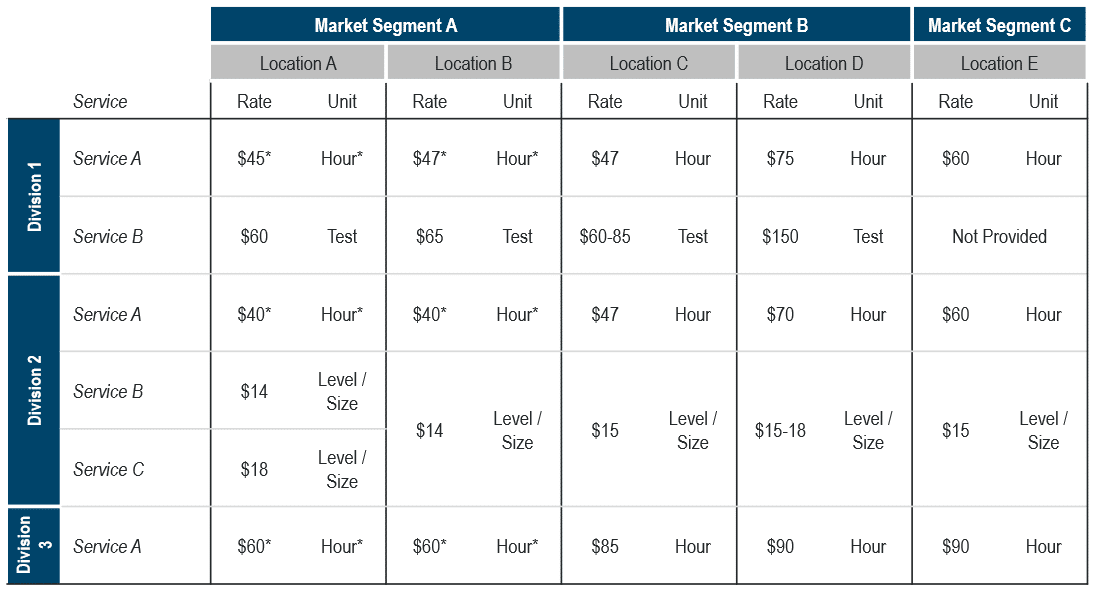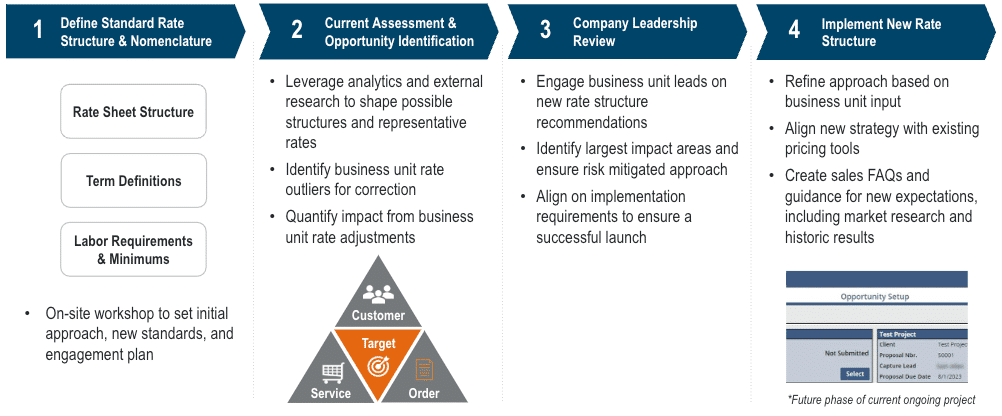Infrastructure TIC and Construction Services
Robust Pricing Framework and Strong Pricing Culture to Drive Margin Growth
Building a Pricing Culture: A Strategic Framework for Margin Growth
An Infrastructure TIC & Construction Services provider implemented a value-aligned pricing framework, driving 4.1% margin growth and organizational buy-in.
With a complex business structure spanning multiple locations, markets, and service lines, this Infrastructure TIC & Construction Services provider struggled with inconsistent pricing and a lack of centralized data. Regional and project-based pricing decisions made standardization difficult, while historical data lacked the necessary details to inform pricing strategies. To address these challenges, the company designed a strategic pricing framework, embedded margin guidance into existing tools, and developed a Pricing Center of Excellence. The result was a 4.1% margin growth, standardized pricing expectations, and a cultural shift towards pricing accountability.
Explore More Case Studies
Situation
Decentralized Pricing Challenges in a Complex Business Environment
- Poor historical data that lacked quality details such as key job attributes
- High degree of business and systems complexity spanning ~125 locations, 7 end-markets, multiple service lines, >10k customers, and >40k projects annually
- Rough margin % targets exist by region but many pricing decisions occur by location and salesperson
- Centralized, standard pricing difficult to implement due to regional and project-based differences
Strategy Findings
Early learnings identified opportunities to standardize rate structures, while also acknowledging limited data availability
Rate Structure
Evidence of Opportunity:
- Standard rate sheets have unexplained/unjustified variability
- Certain services being offered at sub-breakeven multipliers
Steps to Implement:
- Develop internal benchmarking analysis, quantify service price spreads
- Replicate analysis across other business units to confirm opportunity and quantify impact
Align Price to Value
Evidence of Opportunity:
- Value drivers not incorporated in pricing strategy, leading to unrecognized margin based on the value being delivered
- Value based pricing is recognized, but used on a discretionary basis
Steps to Implement:
- Refine key value drivers that can impact pricing
- Complete market research to refine market perception of value-added services
Fee Policies
Evidence of Opportunity:
- Significant variability in how locations charge for value-added services (e.g., project management)
- Labor minimums and other fee policies are disparate
Steps to Implement:
- Develop a policy map to understand, more broadly, current state variability of fees/policies
- Identify the “best practice” fee SOP and embed in quoting application
Pricing Center of Excellence
Evidence of Opportunity:
- Local office pricing autonomy has led to inconsistent approaches to price setting and price changes; best demonstrated by rate variability
- No performance management function
Steps to Implement:
- Develop constructs for a future-state pricing function, including recommendations on degree of centralization and performance management
Example Opportunity Analysis: Rate Variation by Location

Observations:
- Seller-doer model, where those selling were estimating based on their approximations versus data
- While some variation can be justified, significant and unexplained variation is often driven by a lack of a pricing strategy and process
- Market peer groups can be leveraged to understand if there is an opportunity to align rates for markets with similar labor costs and costs to serve
- E.g., Location A charges $30 less than Location D
- *Daily rate normalized based on an 8-hour day
Approach
Establishing a Pricing Framework to Drive Standardization and Performance
- Designed a strategic, value-aligned pricing framework that determines target margins based on market segment, technician specialization, and job requirements
- Embedded margin guidance into client’s existing pricing tools via API to reduce process changes for sales team
- Instilled a “pricing culture” for the field estimators by providing credible, defensible recommendations
- Created a centralized dataset for analytics to provide a trustworthy feedback loop of results, including utilization and cost actuals versus estimates
- Developed a Pricing Center of Excellence that includes a degree of centralization and performance management
Pricing Framework

Organizational Buy-In

Pricing Alignment Drives Margin Growth
Standardized pricing and team buy-in delivered lasting results
Business Services Case Studies

Quick Wins, Foundation for Value, and Centralized, Sustainable Pricing Capability

Strategic, Market-Based Rate Setting to Drive Profit Growth

